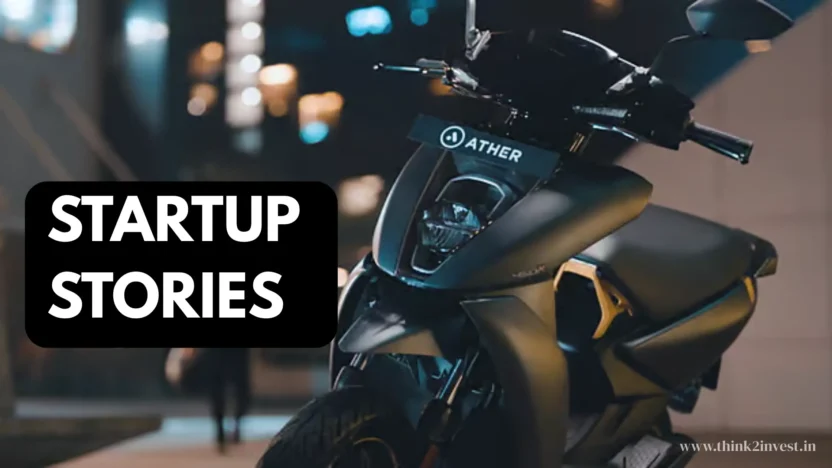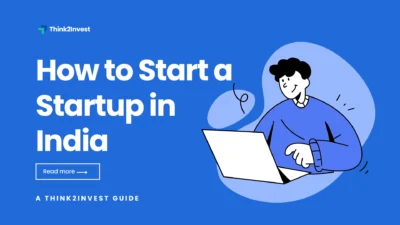Ather Energy
In the early 2010s, when electric vehicles (EVs) in India were almost synonymous with slow, low-quality scooters, two young engineers from IIT Madras had a vision: to redefine personal mobility. Today, Ather Energy stands as one of India’s premier EV startups, setting benchmarks in design, performance, and technology.
Here’s a deep dive into Ather’s journey — from a college project to an EV powerhouse. Also, Key Takeaways from their startup Journey.

🏁 The Early Days: How It All Started
Ather Energy was founded in 2013 by Tarun Mehta and Swapnil Jain, both graduates of the prestigious Indian Institute of Technology (IIT) Madras.
Their initial work revolved around battery pack development. During their college years, Tarun and Swapnil realized that while electric vehicles had great promise, they were let down by poor engineering — especially in battery technology and vehicle design.
Thus, instead of creating retrofitted or compromised products, they decided to build an electric scooter from the ground up — one that could compete with and even surpass petrol scooters on performance, technology, and design.
“We were tired of seeing bad products and thought — why not build something the country can be proud of?” – Tarun Mehta
Their vision was simple yet radical: Smart, connected, fast, electric two-wheelers designed for Indian urban riders.
💸 Securing the First Big Break: Funding and Validation
In the early stages, Ather operated with support from the IIT Madras Incubation Cell and initial seed funding from angels.
The real turning point came in 2015, when Flipkart co-founders Sachin Bansal and Binny Bansal invested $1 million in the startup. This was followed by a $12 million Series A round led by Tiger Global.
The confidence from such high-profile investors not only validated Ather’s vision but also gave them the runway to set up an R&D center, hire top talent, and begin full-scale development of their first product.
⚙️ Years of Research and Development
From 2015 to 2018, Ather spent an intense three years refining their first scooter, the Ather 450.
Key milestones during this time:
- Development of Ather’s proprietary battery pack.
- Creation of an operating system (AtherStack) for vehicle intelligence.
- In-house design of chassis, electronics, and UI/UX interfaces.
- Parallel building of Ather Grid, a fast-charging network exclusively for Ather scooters.
This period was crucial because Ather refused to take shortcuts. Every aspect of the scooter — from motor efficiency to over-the-air software updates — was built to create a futuristic ownership experience.
🛵 The Launch: Ather 450 Hits the Road
In June 2018, Ather officially launched the Ather 450 and the slightly lower-end Ather 340.

Key features of the Ather 450:
- Top speed: 80 km/h.
- Range: 55–75 km per charge (depending on ride mode).
- 0–40 km/h in 3.9 seconds.
- 7″ touchscreen dashboard with navigation, diagnostics, and OTA updates.
- Connected mobile app for remote access and analytics.
Ather was also among the first Indian two-wheeler companies to introduce features like:
- Predictive maintenance alerts.
- Riding behavior analytics.
- Live location tracking.
Initially, the scooters were available only in Bengaluru through a direct-to-consumer model — no dealerships, no middlemen.
📈 Growth Trajectory: Scaling Up
Product Evolution
- In 2020, Ather launched the Ather 450X, an upgraded version with:
- More powerful motor.
- Higher top speed.
- Improved range (~85 km real-world).
- New subscription-based models for connected services.
- In 2023, Ather introduced the Ather 450S, a more affordable variant to expand their consumer base.
Geographic Expansion
After validating the business model in Bengaluru, Ather expanded to other cities: Chennai, Pune, Hyderabad, Mumbai, Delhi, and eventually 30+ cities by 2024.

They also built Ather Grid 2.0, an upgraded fast-charging network with more reliability and speed.
Manufacturing Expansion
To meet growing demand, Ather opened a massive production plant in Hosur, Tamil Nadu, in early 2021, with an annual capacity of 400,000 units. This plant was also designed to manufacture battery packs in-house — a rare move for Indian startups.
💵 Financials: The Numbers Behind the Story
- FY2022: ~₹408 crore.
- FY2023: ~₹1,178 crore.
- FY2024: Estimated ~₹1,784 crore.
Profitability:
- Ather is still loss-making, a deliberate strategy to prioritize R&D, infrastructure building, and customer acquisition.
- Losses FY2022: ₹344 crore; slightly higher in FY2023 and FY2024, but narrowing as scale improves.
Funding:
- Total funding raised (as of 2024): ~$350 million+.
- Major investors include:
- Hero MotoCorp (~30-35% stake).
- Tiger Global.
- Flipkart Founders.
- NIIF (National Infrastructure Investment Fund).
IPO Plans – Ather Energy
- IPO Open Date: April 28, 2025
- IPO Close Date: April 30, 2025
- Issue Type: Book Built Issue
- Total Issue Size:
🚧 Challenges Faced Along the Way
Despite its success, Ather has faced a fair share of hurdles:
- High cost of scooters compared to petrol rivals.
- Dependence on government EV subsidies (like FAME-II).
- Infrastructural limitations — charging ecosystem still evolving.
- Stiff competition from players like Ola Electric, TVS iQube, Bajaj Chetak.
- Global EV slowdown concerns and battery supply chain challenges.
Yet, Ather’s focus on technology leadership, brand loyalty, and superior customer experience has helped it carve a distinct niche.
Readers Suggestion: Why Indian Startups Fail: Lessons and Success Tips
🌍 What’s Next: Future Plans
- Entry into Southeast Asia: Markets like Nepal, Sri Lanka, Bangladesh.
- Electric Motorcycles: Ather is rumored to be working on a high-performance motorcycle for launch around 2026.
- Advanced Software Services: Including AI-driven riding tips, predictive battery health analytics.
- Battery Innovation: Research into solid-state batteries and longer-range battery packs.
- IPO: Public listing to fuel future R&D, global expansion, and new product lines.
📚 Key Learnings from Ather Energy’s Story
1. Solve Real Problems Deeply, Not Superficially
- Ather didn’t just build another scooter — they reimagined the two-wheeler itself:
- Better battery packs
- Intelligent software
- Fast charging grids
- Deep product innovation created lasting differentiation.
✅ Lesson: Solve fundamental problems better than anyone else, not just surface-level improvements.
2. Persistence Through Long R&D Cycles
- They spent 3-4 years building their first product before even selling it.
- Most startups rush to market — Ather was patient, knowing quality builds trust.
✅ Lesson: Great products take time. Early patience = long-term brand equity.
3. Right Early Backers Matter
- Early investors like Flipkart founders and Tiger Global gave Ather credibility, funding, and strategic guidance.
- Later, Hero MotoCorp’s investment added industrial and scale muscle.
✅ Lesson: Choose investors who align with your vision, not just those who offer money.
4. Building the Ecosystem, Not Just the Product
- Ather didn’t stop at scooters.
→ They built Ather Grid for charging.
→ Developed AtherStack, their own software platform.
✅ Lesson: In emerging industries, controlling key parts of the ecosystem can be a major advantage.
5. Branding Matters in Traditional Industries
- Ather positioned itself as a premium, smart, aspirational brand — not just “cheap and electric.”
- In a market crowded with low-end EVs, they stood out by offering a “Tesla-like” scooter experience.
✅ Lesson: Brand positioning is critical — especially in industries where products seem similar.
6. Adapt Pricing Models to Win Over Customers
- They introduced subscription services for software features (flexible pricing).
- They launched a more affordable Ather 450S when market demanded lower-priced EVs.
✅ Lesson: Evolve your pricing and product lines based on customer feedback and market shifts.
7. Stay Mission-Driven Despite Competition
- Despite Ola Electric’s aggressive moves, Ather stayed focused on premium, tech-first products.
- They didn’t panic and abandon their DNA.
✅ Lesson: Competitor moves should inform you, but not derail you from your core mission.
🌟 Summary
“The Ather story is a masterclass in deep innovation, patient building, smart partnerships, and brand-first thinking.”
If you’re building anything today — whether a startup, product, or even a personal brand — you can apply these exact principles.






Wonderful article! That is the type of info that are supposed to be shared around the net.
Disgrace on Google for now not positioning this post
higher! Come on over and talk over with my website .
Thanks =)